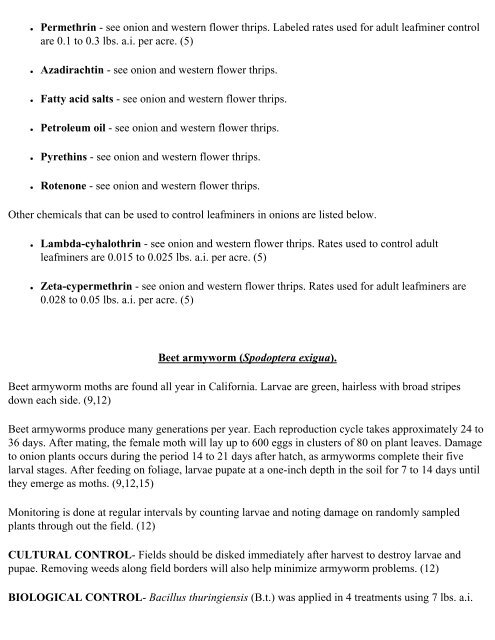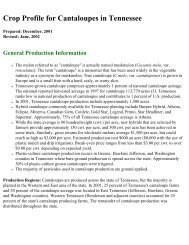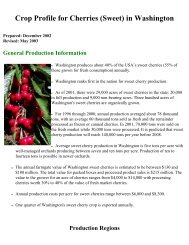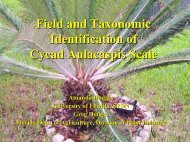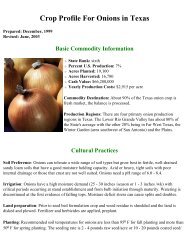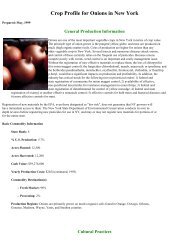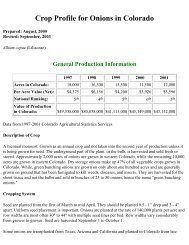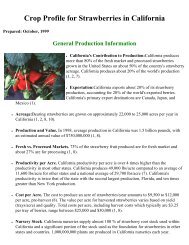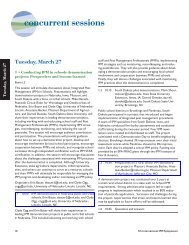Crop Profile for Onions in California - Regional IPM Centers
Crop Profile for Onions in California - Regional IPM Centers
Crop Profile for Onions in California - Regional IPM Centers
Create successful ePaper yourself
Turn your PDF publications into a flip-book with our unique Google optimized e-Paper software.
● Permethr<strong>in</strong> - see onion and western flower thrips. Labeled rates used <strong>for</strong> adult leafm<strong>in</strong>er control<br />
are 0.1 to 0.3 lbs. a.i. per acre. (5)<br />
● Azadiracht<strong>in</strong> - see onion and western flower thrips.<br />
● Fatty acid salts - see onion and western flower thrips.<br />
● Petroleum oil - see onion and western flower thrips.<br />
● Pyreth<strong>in</strong>s - see onion and western flower thrips.<br />
● Rotenone - see onion and western flower thrips.<br />
Other chemicals that can be used to control leafm<strong>in</strong>ers <strong>in</strong> onions are listed below.<br />
● Lambda-cyhalothr<strong>in</strong> - see onion and western flower thrips. Rates used to control adult<br />
leafm<strong>in</strong>ers are 0.015 to 0.025 lbs. a.i. per acre. (5)<br />
● Zeta-cypermethr<strong>in</strong> - see onion and western flower thrips. Rates used <strong>for</strong> adult leafm<strong>in</strong>ers are<br />
0.028 to 0.05 lbs. a.i. per acre. (5)<br />
Beet armyworm (Spodoptera exigua).<br />
Beet armyworm moths are found all year <strong>in</strong> Cali<strong>for</strong>nia. Larvae are green, hairless with broad stripes<br />
down each side. (9,12)<br />
Beet armyworms produce many generations per year. Each reproduction cycle takes approximately 24 to<br />
36 days. After mat<strong>in</strong>g, the female moth will lay up to 600 eggs <strong>in</strong> clusters of 80 on plant leaves. Damage<br />
to onion plants occurs dur<strong>in</strong>g the period 14 to 21 days after hatch, as armyworms complete their five<br />
larval stages. After feed<strong>in</strong>g on foliage, larvae pupate at a one-<strong>in</strong>ch depth <strong>in</strong> the soil <strong>for</strong> 7 to 14 days until<br />
they emerge as moths. (9,12,15)<br />
Monitor<strong>in</strong>g is done at regular <strong>in</strong>tervals by count<strong>in</strong>g larvae and not<strong>in</strong>g damage on randomly sampled<br />
plants through out the field. (12)<br />
CULTURAL CONTROL- Fields should be disked immediately after harvest to destroy larvae and<br />
pupae. Remov<strong>in</strong>g weeds along field borders will also help m<strong>in</strong>imize armyworm problems. (12)<br />
BIOLOGICAL CONTROL- Bacillus thur<strong>in</strong>giensis (B.t.) was applied <strong>in</strong> 4 treatments us<strong>in</strong>g 7 lbs. a.i.


